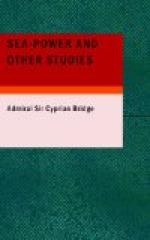The area of Phoenician maritime commerce was vast
enough both to excite jealousy and to offer vulnerable
points to the cupidity of rivals. It is probable
that the modern estimate of the sea-power of Carthage
is much exaggerated. It was great by comparison,
and of course overwhelmingly great when there were
none but insignificant competitors to challenge it.
Mommsen holds that, in the fourth and fifth centuries
after the foundation of Rome, ’the two main
competitors for the dominion of the Western waters’
were Carthage and Syracuse. ‘Carthage,’
he says, ’had the preponderance, and Syracuse
sank more and more into a second-rate naval power.
The maritime importance of the Etruscans was wholly
gone.... Rome itself was not exempt from the
same fate; its own waters were likewise commanded by
foreign fleets.’ The Romans were for a
long time too much occupied at home to take much interest
in Mediterranean matters. The position of the
Carthaginians in the western basin of the Mediterranean
was very like that of the Portuguese long afterwards
in India. The latter kept within reach of the
sea; ’nor did their rule ever extend a day’s
march from their ships.’[18] ’The Carthaginians
in Spain,’ says Mommsen, ’made no effort
to acquire the interior from the warlike native nations;
they were content with the possession of the mines
and of stations for traffic and for shell and other
fisheries.’ Allowance being made for the
numbers of the classes engaged in administration,
commerce, and supervision, it is nearly certain that
Carthage could not furnish the crews required by both
a great war-navy and a great mercantile marine.
No one is surprised on finding that the land-forces
of Carthage were composed largely of alien mercenaries.
We have several examples from which we can infer a
parallel, if not an identical, condition of her maritime
resources. How, then, was the great Carthaginian
carrying-trade provided for? The experience of
more than one country will enable us to answer this
question. The ocean trade of those off-shoots
or dependencies of the United Kingdom, viz. the
United States, Australasia, and India, is largely or
chiefly conducted by shipping of the old country.
So that of Carthage was largely conducted by old Phoenicians.
These may have obtained a ‘Carthaginian Register,’
or the contemporary equivalent; but they could not
all have been purely Carthaginian or Liby-Phoenician.
This must have been the case even more with the war-navy.
British India for a considerable time possessed a
real and indeed highly efficient navy; but it was
officered entirely and manned almost entirely by men
from the ‘old country.’ Moreover,
it was small. The wealth of India would have
sufficed to furnish a larger material element; but,
as the country could not supply the personnel,
it would have been absurd to speak of the sea-power
of India apart from that of England. As soon
as the Romans chose to make the most of their natural
resources the maritime predominance of Carthage was




